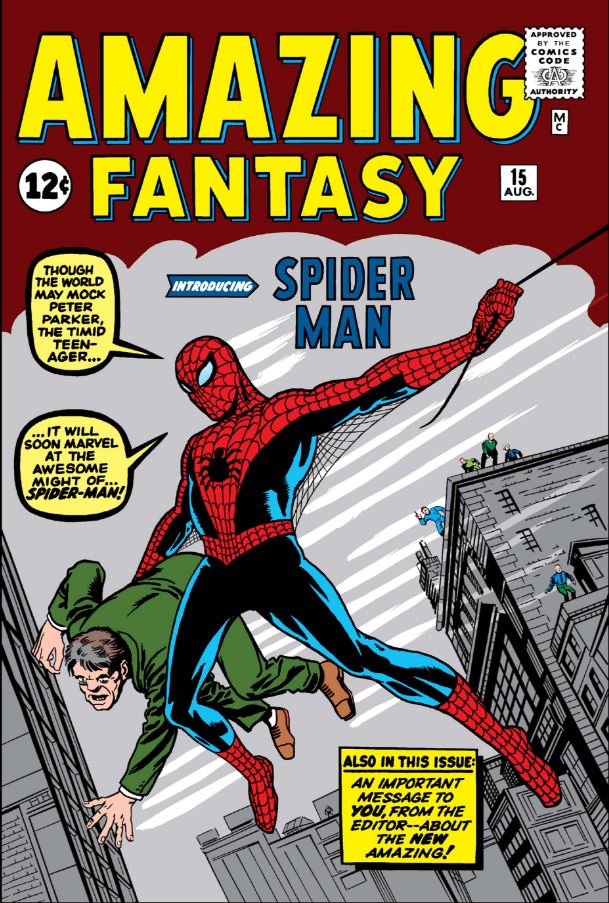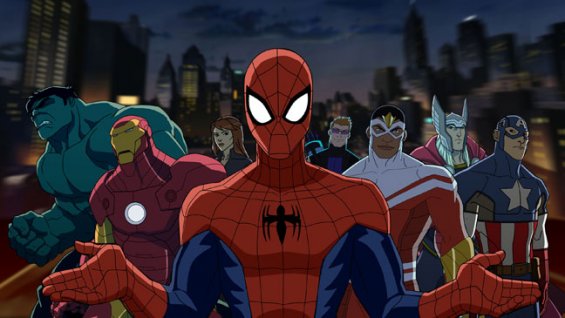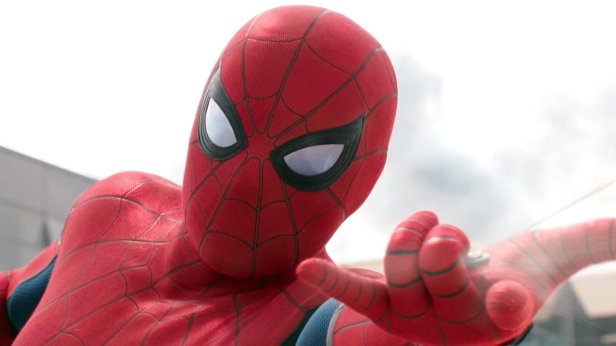Many people put Spider-Man next to Superman and Batman when ranking their favorite superheroes, and many even rank him above the two DC powerhouses. I can tell you with certainty that among Marvel’s cast of characters Spider-Man is my favorite because 1. I like underdogs. 2. He’s hilarious (I never laughed out loud at the dialogue in any comic book before the eighties until I read Stan Lee’s scripts). And 3. His stories are among the most realistic superhero stories ever written. All three of these criteria mark many of Marvel’s best comics and were the main reasons why they eventually eclipsed DC in popularity.
Created in 1962 by writer Stan Lee and artist Steve Ditko and first appearing in issue #15 of the anthology comic Amazing Fantasy, Spider-Man was notable for being one of the first teen superheroes without an adult mentor (Robin had Batman, Spider-Man was on his own). The realistic approach to the teenage character behind the mask contributed heavily to his popularity not just with kids but with college-age readers.
Throughout the many iterations of the series through the decades, Peter Parker went from a high school student to a college student to a high school teacher to an Avenger. These series include The Amazing Spider–Man, The Spectacular Spider–Man, Web of Spider–Man, The Sensational Spider–Man, Superior Spider–Man and way too many more to list on this blog. There have also been alternate versions of the character throughout the history of the comic books, such as Spider–Man 2099 (about Miguel O’Hara, the Spider-Man of the future), Ultimate Spider–Man (about Peter Parker in an alternate timeline where he gets his spider powers in the 21st century) and Ultimate Comics Spider–Man which follows Ultimate Peter Parker’s successor, Miles Morales.
Don’t even ask me about these:
There are a LOT of Spider-Man comics. It was even one of the few comic books that made a successful transition from retail to newspaper dailies in 1977.
From the beginning the comic book had a strong cast of characters for a superhero story. Aunt May, Mary Jane Watson, Gwen Stacy, J. Jonah Jameson and others were all given dimensionality and humor. Plus, the rogues gallery was just as great. Some of the most entertaining supervillains I’ve ever seen originated from Spider-Man stories. Some of my favorites:
The Spider-Man comics were so popular that they have been adapted into TV series at least twice a decade after the sixties. The first one was the animated Spider–Man (ABC, 1967-1970) which originated the now famous theme song (“Spider-Man, Spider-Man, does whatever a spider can”).
Following that series:
- Spidey Super Stories (a recurring segment from The Electric Company on PBS, running from 1974 to 1977).
- The Amazing Spider–Man (CBS, 1978-79) was the first live action Spider-Man show.
- Spider–Man (1981-82) ran in syndication.
- Spider–Man and his Amazing Friends (1981-83) was a popular show.
- Spider–Man (Fox Kids, 1994-98) was by far the most popular and critically acclaimed series to date, mainly because it faithfully adapted the comic books better than any of the previous shows.
- Spider–Man Unlimited (Fox Kids, 1999-2000) never had a chance against Pokémon and Digimon, which premiered around the same time.
- Spider–Man: The New Animated Series (MTV, 2003) was also acclaimed by critics but not as commercially successful.
- The Spectacular Spider–Man (CW, 2008-09) was one of the last great saturday morning cartoons but it was also not commercially successful.
- Ultimate Spider–Man (Disney XD, 2012-17) recieved mixed reviews. It was more comedic than previous shows but not clever enough to match its attitude, which bordered on Family-Guy-style wackiness. It has a significant fan following though, becoming the most popular Spider-Man series since the nineties.
The character’s popularity skyrocketed even further when Sam Raimi directed the first live-action Spider-Man feature film and it became a well-deserved hit at the box office in 2002 and helped usher in the Hollywood superhero explosion. Spider–Man 2 (2004) and Spider–Man 3 (2007) finished off Sam Raimi’s trilogy but Sony rebooted the series in 2012 with The Amazing Spider–Man and its sequel The Amazing Spider–Man 2, both directed by Marc Webb and both not as well-recieved as the previous Spider-Man movies.
Sony completely abandoned their plans after the poor reception of ASM2 but they have given him new life with Disney in the Marvel Cinematic Universe when they let the Russo brothers borrow him for a role in Captain America: Civil War. Now Sony and Disney are teaming up for Spider–Man: Homecoming directed by Jon Watts, which looks to bring some high school spirit back into the series. Meanwhile, Sony has its own plans for spin-off films involving Venom, Black Cat and Silver Sable, not to mention an animated Spider-Man film about Miles Morales, the character from the Ultimate Comics Spider–Man book who replaces Peter Parker.
Oh, and there’s one other bizarre but noteworthy evolution of this character. In 2011, the musical Spider–Man: Turn Off the Dark made its Broadway debut with music and lyrics by U2’s Bono and The Edge and became the most expensive musical in Broadway history ($70 million). Remember that? Just another string to add to Spidey’s web of domination.
















The Spider-Girl comics are pretty cool.
LikeLiked by 1 person
Agreed. Even if they do take place in an alternate reality.
LikeLiked by 1 person